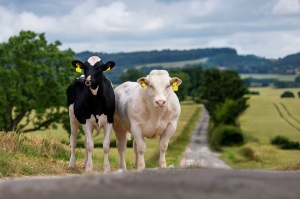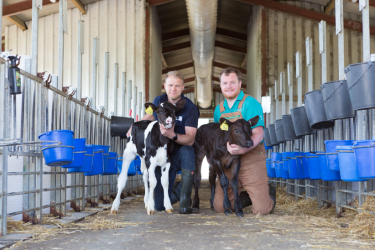What is beef on dairy?
Beef on dairy is an opportunity to increase the value of a dairy herd by cross-breeding dairy cows with beef cattle.
Dairy beef has evolved over the years as genetic improvements have been made. Today the way dairy cattle are selected and priced has changed.
There are a number of key differences between dairy and beef cattle. Dairy cattle are bred for their milk production quality. They tend to be more angular, and can be identified by their large udders.
Some of the most common breeds of dairy cattle are the Holstein, the Jersey and Guernsey. They’ve been bred to produce large amounts of milk and sustain multiple lactations, far in excess of what their calves needs.
Holstein dairy herds are able to produce large quantities of milk with a lower fat content, while Jersey and Guernsey cows are prized for their high fat dairy production.
Change in the dairy industry
Change in the beef and dairy industry can be slow, but when it comes to beef on dairy, change has been somewhat rapid.
Dairy producers have been turning to beef production in order to increase profit margins on the dairy farm. As such, dairy beef is playing an ever growing role in the meat production industry and the beef market.
Holstein steers have long contributed to around 15-19% of the beef supply. In the upper echelons, Holstein steers supplies up to 40% of all the premium beef produced too.
Over the past few years, this has begun to lower as beef cattle have begun to grade more highly. Now that herd reproductive performance can be more targeted and controlled by beef and dairy farmers, beef production from dairy calves has really begun to transform.
What has driven the change to beef on dairy?
Beef on dairy has become a profit point for dairies, rather than a by-product of milk production. Dairy producers can use genomics and to identify the best dairy females to use to create their dairy replacements, and then convert the remainder of their herd to beef on dairy.
By cross breeding their lower performers with beef breeds using high quality beef genetics, their herd can still be utilised to create milk, while also adding value to the dairy herd.
A large proportion of dairy farms are now using beef semen on dairy cows.
Some of the main reasons reported include extra profit as the main advantage of using beef semen, followed by control of heifer inventory, and then overall genetic improvement.
The percentage of the dairy herd that can be bred for beef on dairy depends on a number of factors including:
- Reproductive efficiency – the higher the reproductive efficiency the more cows can be devoted to beef reproduction
- Growth status of the dairy farm – if a dairy farm is in growth mode more dairy females are needed
- Use of sexed semen – using sexed semen can help to guarantee female replacements early in the breeding season so that later-born calves can be created for beef.
In most herds, though, with the right breeding strategies, at least 50% could be devoted to beef on dairy production, improving the market value of the overall herd.
For example, a Holstein dairy calf fetches around $50. But Holstein cross bred with Angus beef sires can fetch up to $250.
Per 1000 dairy cows:
500 Holstein calves at $50 will make a dairy farmer $25000.
500 Holstein x Angus calves at $250 will fetch a dairy on beef farmer $125000 at beef markets.
Growth of beef on dairy
Current market conditions have fuelled the growth of beef on dairy programs, which provide flexibility and economic opportunities for dairy farmers and livestock.
A large majority of dairy farms are now investing in beef semen for improved beef genetics in their dairy herds. In fact, beef semen sales have doubled since 2017.
2015 – 2 million units of beef semen going into dairy herds
2020 – this number rose to 7 million
2021 – it stood at 8.7 million
2024 – it is estimated that 12-13 million units of beef semen will be sold in the US alone.
Are dairy cows good for beef?
With the growing use of artificial insemination, using lower performing dairy cows to produce beef calves is a sensible move.
In fact, estimations predict that around 60% of all dairy herd inseminations will be made to beef, using beef semen, by 2030.
While the switch to beef on dairy seems simple, it should not be undertaken without a clear business plan to back it up. Achieving the best outcome requires a careful assessment of the farm’s goals and a good understanding of the beef industry and beef on dairy market.
To gain success, dairies usually select the top 30-50% of cows to breed for replacement heifers, using sexed semen.
The lower 50-70% of cows still need to be bred to continue producing milk, but beef on dairy farmers are choosing beef semen.
While the main goal is to get milk from dairy herds, using beef semen can improve the carcass characteristics of the remaining dairy cattle, to improve beef production, and make the beef calves more marketable for a profit.
The use of sexed semen in dairy cattle
Genomic testing and sexed semen have made it more possible than ever to create a successful beef on dairy breeding program.
There is now accuracy in breeding replacements for dairy cattle, meaning higher producing dairy cows can be bred for replacement heifers, and the lower-end cattle can make good candidates for breeding with beef bulls.
These lower-end heifers can still produce milk, but often it takes 2-3 lactations to pay off the cost of a heifer, so selling beef cross calves can help to bring profit to the farm more quickly.
Choosing the right beef genetics
In order to ensure a successful beef on dairy breeding program, it’s crucial to choose the right beef semen for the genetic gain you’re looking for.
Recent studies show that Angus semen is the most widely used for crossbred beef, followed by Limousin, and Wagyu, with smaller proportions choosing beef semen from Charolais, Limflex, Stabilizer, Hereford and Simmental.
The key is to understand the beef traits you are looking for in your crossbred calf, and then compare genetic potential from the beef bull versus actual performance in your herd to understand which traits support long-term profitability.
This means you need to understand which genetic traits are going to support your overall business plan for beef on dairy. Choosing too many will lead to slow genetic progress, but choosing the wrong genetic traits for your business plan will have a long-term impact on the profitability of your operation.
Your beef on dairy business plan
There is better technology available now than ever before, and it continues to improve. Genomic testing allows for more precision and reliability, and makes it easier to weigh up the raising costs with the final market value.
Once you have determined the cull rate of your herd (whether you’re expanding, maintaining or reducing), you can focus on your first half replacement heifers, and ensuring you have the right number to refresh the loss of milking cows for that season.
You can determine which of your heifers are the best milk producers, and breed your top third for your replacements.
When this is taken care of, you’ll know how many heifers are remaining to breed for beef calves, and you can use genomic testing to determine the optimum cross breeds for improved beef production, e.g. the best genetics for increased muscle, superior beef marbling, or even calving ease.




